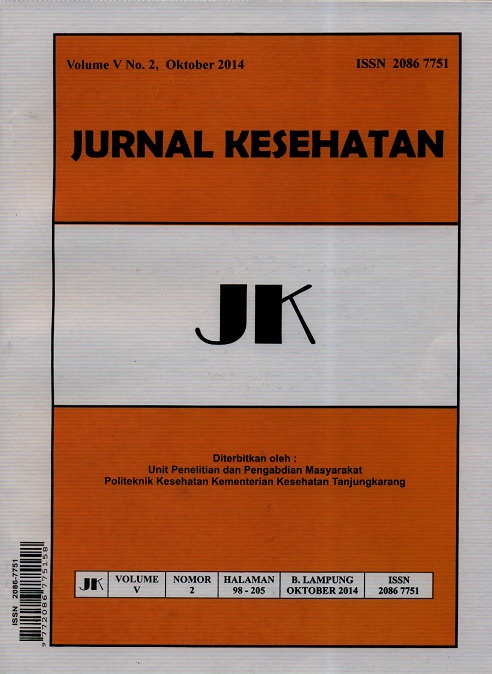PENGOLAHAN AIR LIMBAH SAMPAH (LINDI) DARI TEMPAT PEMBUANGAN AKHIR SAMPAH (TPA) MENGGUNAKAN METODA CONSTRUCTED WETLAND
DOI:
https://doi.org/10.26630/jk.v5i2.39Abstract
Sarip Usman1)
Imam Santosa1)
Â
1)Jurusan Kesehatan Lingkungan Poltekkes Kemenkes Tanjungkarang
Â
Abstract: Waste Water Treatment (Leachate) From Waste Final Disposal Method Using Constructed Wetland. Leachate from the landfill is waste water that has a high content of pollutants. The high content of pollutant impacts on public health and the ecosystem around the location of waste disposal (landfill). It is therefore important to leachate treatment before being discharged into water bodies. Method one way Constructed Wetland used for leachate treatment that utilizes symbiotic microorganisms in the soil and plant roots. This method does not require high costs in operations and maintenance due to take place naturally, so it can be a solution to the constraints of cost, technical and operational system of conventional processing. The purpose of this study is the objective of this study is to obtain the ability of Constructed Wetland method in reducing the content of COD, BOD and nitrite from Leachate. Experimental research is conducted, the research design is experimental observations before the experiment (Pre Test) and after the experiment (Post Test). The results showed a decrease in the concentration of COD, BOD, nitrite and pH leachate using a horizontal flow medium flowing over the surface are 28%, 27%, 46%, and 4%, using  a horizontal flow medium flows through  are 64%, 64%, 93%, and 5%, and decrease in concentration ability of COD, BOD, nitrite and pH in the reactor that uses flow constructed Wetland plants pass through the media more compared the ability of Constructed Wetland decrease in reactor that uses flow medium flowing over the surface of the plant.
Â
Keywords : Method, Constructed Wetland
Â
Abstrak : Pengolahan Air Limbah Sampah ( Lindi ) Dari Tempat Pembuangan Akhir Sampah ( TPA ) Dengan Menggunakan Metoda Constructed Wetland.Lindi dari TPA adalah air limbah yang memiliki kandungan pencemar tinggi. Tingginya kandungan pencemar berdampak pada kesehatan masyarakat dan ekosistem di sekitar lokasi tempat pembuangan akhir sampah (TPA). Oleh karena itu penting dilakukan pengolahan lindi sebelum dibuang ke badan air. Metoda Constructed Wetlandsalah satu cara yang digunakan untuk pengolahan lindi yang memanfaatkan simbiosis mikroorganisme dalam tanah dan akar tanaman. Metoda ini tidak memerlukan biaya yang tinggi dalam operasional dan pemeliharaannya karena berlangsung secara alamiah, sehingga dapat menjadi solusi untuk kendala biaya, teknis dan operasional sistem pengolahan konvensional. Tujuan penelitian ini adalah Tujuan penelitian ini adalah diperolehnya kemampuan Metoda Constructed Wetland dalam menurunkan kandungan COD, BOD dan N dari air Lindi. Penelitian yang dilakukan bersifat Eksperimen, dengan rancangan penelitian bersifat eksperimen melakukan observasi sebelum eksperimen (Pre Test) dan sesudah eksperimen (Post Test). Hasil penelitian memperlihatkan penurunan kosentrasi COD, BOD, Nitrit dan pH air lindi dengan menggunakan aliran horizontal mengalir di atas permukaan media tanaman adalah 28 %, 27 %, 46 %, dan 4 %, aliran horizontal mengalir melewati media adalah 64 %, 64 %, 93 %, dan 5 %, dan kemampuan penurunan kosentrasi COD, BOD, Nitrit dan pH pada reaktor aliran melewati media tanaman lebih tinggi dibandingkan kemampuan penurunan reaktor Constructed Wetland yang menggunakan aliran mengalir di atas permukaan media tanaman.
Â
Kata Kunci : Metoda, Constructed Wetland
Downloads
Additional Files
Published
Issue
Section
License
Authors who publish in this journal agree to the following terms:
- Authors retain copyright and grant the journal right of first publication with the work simultaneously licensed under a Creative Commons Attribution License (CC BY-SA 4.0) that allows others to share the work with an acknowledgment of the work's authorship and initial publication in this journal.
- Authors can enter into separate, additional contractual arrangements for the non-exclusive distribution of the journal's published version of the work (e.g., post it to an institutional repository or publish it in a book), with an acknowledgment of its initial publication in this journal.
- Authors are permitted and encouraged to post their work online (e.g., in institutional repositories or on their website) prior to and during the submission process, as this can lead to productive exchanges and earlier and greater citations of published work.












